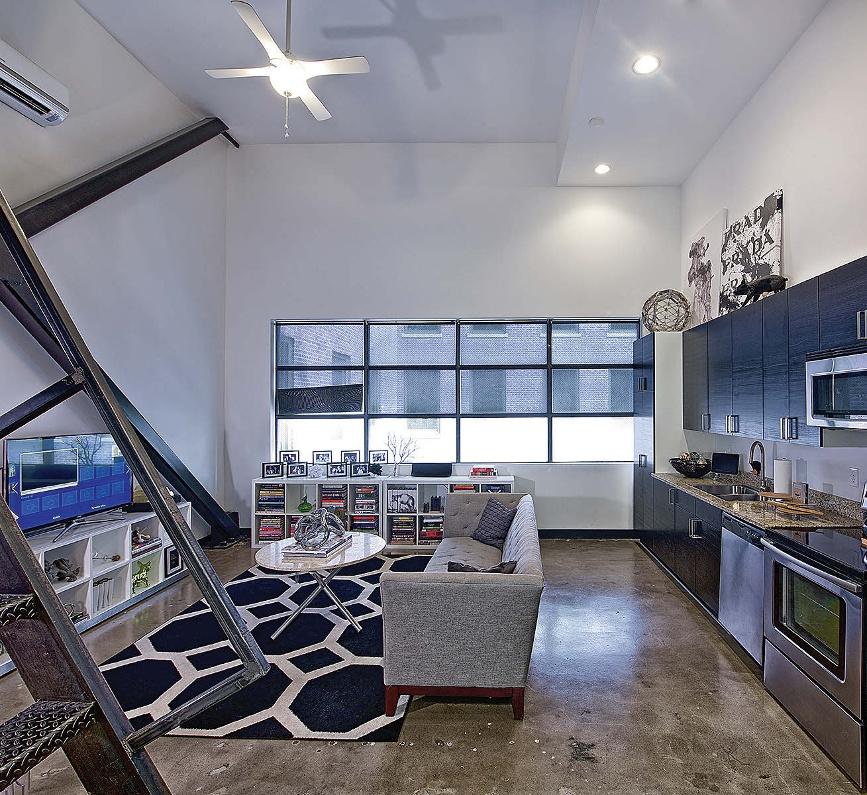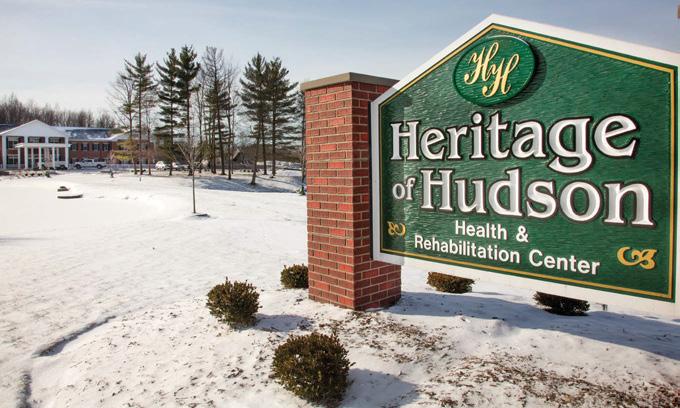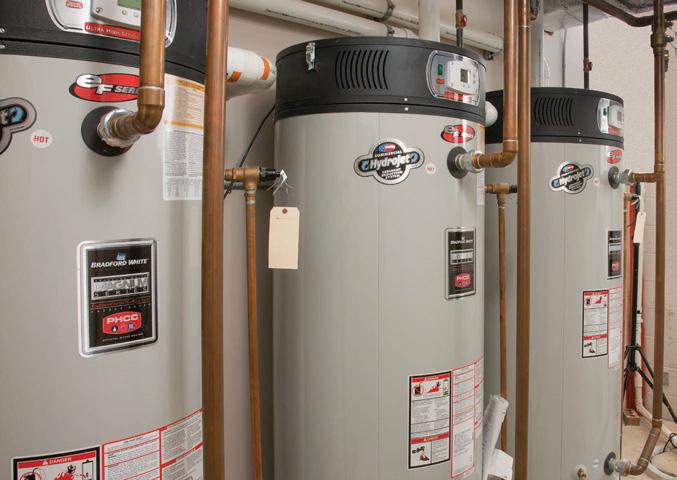
9 minute read
Water Heaters Deliver For Amish
from commARCH - June 2015
by IdeaSoil

Top. Converted to 40 loft apartments, the building features high ceilings. The ability to bend AquaPEX piping around corners and run it through tight spots without fittings allowed a cost-effective plumbing layout.
Advertisement
Above. To maximize efficiency and cooperation with other contractors, pipe was precut and brackets were installed as rooms were being framed. Project manager Todd Ringgold, of Palmer Mechanical, Tulsa, OK, is shown making piping connections. amenities people are accustomed to,” he said.
The most significant challenge to accomplishing this compromise between old and new is the efficient use of space for the building’s infrastructure. “Having chases, wiring, ductwork, and piping hanging everywhere ruins the building’s historic charm, so we can’t have that,” said Snyder. Unfortunately, the question of where to install this infrastructure posed a vexing issue. For example, tenants like the high ceilings in such buildings, but the higher the ceiling, the tighter the space for running mechanical, electrical, and plumbing lines.
The problem is aggravated when copper or some other rigid piping system is used. Every additional copper fitting not only uses more space, but also increases the system’s potential number of leak points. Cramped conditions in the historic building—between the ceilings and the floors above—create a difficult and potentially dangerous situation when it comes to making weld connections. Finally, copper’s rising cost can add significant financial strain to any restoration project. It was clear, then, that if the renovation could avoid copper plumbing, it definitely should.
PEX TO THE RESCUE Fortunately for Brickhugger, the company had restored buildings before, including Tulsa’s Mayo Hotel, using a more cost-effective, flexible, and durable plumbing system designed with PEX piping.
PEX, an acronym for crosslinked polyethylene, is a growing alternative to traditional rigid piping systems. Uponor’s particular type, PEX-a, marketed under the trade name AquaPEX, is crosslinked during the manufacturing process when polyethylene is in its amorphic state. This results in a uniform and flexible product. This flexibility, along with its availability in long coils, drastically reduces the required fittings and connections. Eliminating fittings means less material, less installation labor, and fewer potential leak points, resulting in more-efficient installs and lower costs.
Snyder knew PEX-a piping’s advantages from prior restorations, and didn’t doubt that it would serve equally well in the Vandever project. The lack of wiggle room when redoing the infrastructure of an historical building means the plumbing system needs to be as flexible as possible. To complete the work, Brickhugger employed Todd Ringgold of Palmer Mechanical, a Tulsa-based mechanical contractor that has made historical renovations a major part of its business in recent years.
The project called for 40 loft spaces, each containing its own kitchen, bathroom, water heater, and a ductless mini-split HVAC system, which was another way to save space and preserve the building’s historical aesthetic. Ringgold emphasized the importance of the project being design-built when it came to plumbing, meaning that the team could lay out the network of risers and pipe branches as they saw fit. “It was great because we had the freedom to ‘make it work,’” said Ringgold.
PEX pipe’s flexibility made “making it work” all the easier. Although the team managed to salvage the vertical copper water main running from the basement, PEX was used for the rest of the water supply lines. The ability to bend the piping around corners and run it through tight spots without fittings allowed Ringgold to create a more cost-effective plumbing layout. For example, he reduced the spacing between the plumbing lines in most units by installing the kitchen sink on the same wall as the bathroom. This reduced the size of the required soffit, allowing the ceilings to be higher (around 13 ft.) and preserving the building’s desired aesthetic.
The reduction in fittings proved to be a monumental job saver. “Using PEX, we were able to have 25- to 30-foot pipe runs from the water main in the hallway to the individual fixtures in the rooms,” he said.
Long pipe runs proved especially beneficial in running water lines through a
4-in. space in the bathroom. “Had we used copper, it would have taken significantly more effort to connect those fittings in such a tight space,” estimated Ringgold. “Copper would have required roughly 40% more labor and cost twice as much.”
Overall, the team installed 10,500 ft. of PEX-a in the building, running 1 1/2-in. piping in the hallways and 3/4-in. and 1/2-in. piping in the apartments. To maximize efficiency and cooperation with other contractors, Ringgold would pre-cut the pipe and install brackets as rooms were being framed. Once the rooms were completed, he would run the pipe through. “The entire job flowed really well,” reported Ringgold.
A BRIGHT FUTURE Since the restoration was completed in July 2014, Brickhugger’s Snyder has been thrilled. “We haven’t received any plumbing service calls at all,” he reported, an achievement he attributes to PEX-a piping’s ability to expand and contract, minimizing the threat of pipe bursts. He also praises the piping’s simple color coding—red representing the hot-water lines and blue representing the cold-water lines.
Interestingly, Snyder notes that many of the building’s tenants are in their 20s and 30s. “It seems all the younger people want to live in the old buildings these days,” he observed. Indeed, urban centers across the country that were once thriving commercial districts a century or more ago are increasingly being renovated due to greater demand from today’s younger generation. It’s the reason why Brickhugger restores old buildings, instead of tearing them down and constructing new ones.
The younger crowd is a hopeful sign for the Vandever building’s future. It reveals a respect and appreciation for what came before, an indispensable attitude if historical buildings are to survive into the next century. Still, many of these tenants might be intrigued to learn that 90 years ago, someone just their age was probably standing at a cash register where they are now sleeping. CBP
Want more information? The resources below are linked in our digital magazine at cbpmagazine.com/digital/jun2015.
Circle 9 on the Reader Service Card.
Get information on PEX riser applications. Watch logic plumbing with multiport tees.
Learn about commercial fl ush bank with PEX. Explore fi xture termination options for plumbing systems.
Get information from a pipingsystem engineer reference guide.

Water Heaters Deliver For Amish Water heaters ensure safety and comfort at short-term and outpatient facility serving an Amish community.
Top. At the newly constructed Heritage of Hudson Health and Rehabilitation Center, Amish mingle with “English” folk when it comes to healthcare.


Above. Three 100-gal., 199 MBH natural-gas eF Bradford White water heaters supply domestic hot water for 45 private rooms, a large kitchen, public restrooms, and other common areas.
Want more information? The resources below are linked in our website and digital magazine at cbpmagazine.com/digital/jun2015.
Circle 8 on the Reader Service Card.
Download a brochure on the Bradford White eF water heater. I n a part of the world where the locals avoid most modern services and amenities—such as grid power, air conditioning, and automobiles—this 24-hr. health and rehabilitation center stands out as a high-tech resource for modern-day healthcare. The facility is located in Hudson, OH, an area known for its large population of Amish. Though Amish beliefs shun the great majority of contemporary services, healthcare is an exception.
At the newly constructed Heritage of Hudson Health and Rehabilitation Center (or, simply, Heritage Center), Amish mingle with “English” folk when it comes to healthcare. The
Heritage Center is a short-term and outpatient facility for patients that have undergone orthopedic reconstruction and joint replacements.
“Our task was to provide all of the plumbing work the rehab center required,” explained Joe
Hochstetler, owner of Berlin Plumbing, Berlin,
OH. Hochstetler and his crew were tapped to provide mechanical systems for the $3-million, 36,500-sq.-ft. facility, to the tune of about $250,000.
Before the blueprints were drawn and the heat-load calculations were definitive, Hochstetler had already determined the means for the facility’s domestic hot water. “With a capacity of 45 patients, and with 130 hot water fixtures in the building, we arrived at a tight domestic hot water calculation of 600,000 BTU/ hr.,” said Hochstetler. “And, because it’s a healthcare facility, we knew there’d be no tolerance for water-heating equipment with slow recovery or downtime.”
Three months after Hochstetler presented the plan, one of Berlin’s two-man crews was hard at work on the job. The team of technicians was there for eight months, installing three 100-gal., 199 MBH natural-gas eF Bradford White water heaters. The equipment now heats domestic water for 45 private rooms, a large kitchen, public restrooms, and a few other common areas. The Bradford White company is located in Ambler, PA.
“Even though the facility uses about 1,000 gal. of hot water a day, the water heaters easily keep pace with the need,” said Alan Hershberger, plumbing technician at Berlin Plumbing.
“It’s pretty amazing when, after what seems like a flawless installation, you’re rewarded with a quick response from the appliance,” added Hochstetler. “We activated the unit and very quickly had 100 gal. of hot water ready to go.”
The water heaters are piped such that water is drawn from all three heaters so as not to over-exert one of them. According to Hochstetler, he prefers the parallel piping arrangement. By design, he sets the heaters to produce 140 F water, which leaves the heaters at that temperature, bound for the kitchen, assuring the availability of an adequate water temperature for proper cleaning. Downstream from the kitchen, a tempering valve sees to it that water is reduced to 120 F to serve the rest of the facility’s hot water needs.
The higher internal set-temp assures that Legionella bacteria and other unwanted microorganisms can’t survive or multiply. “They may enter the incoming domestic-water stream, but they won’t survive the internal temperature.”
The Berlin Plumbing crew also installed a hot-water recirculating pump with an insulated, dedicated return line to maintain consistent temperatures within the facility at all times.
“I like the efficiency and the design of the eF water heaters. Having the burner on top of the heater and for the heat itself to make three passes through the heat exchanger is a smart way to wring out BTUs efficiently. The water heaters achieve 98% thermal efficiency—and those are the sort of numbers our clients are happy to pay for,” he said.
The management team at Berlin Plumbing has standardized on Bradford White water heaters and products. Technical crews have installed the company’s products consistently over the past 15 years and have been using the commercial eFs since their introduction more than 10 years ago. CBP







